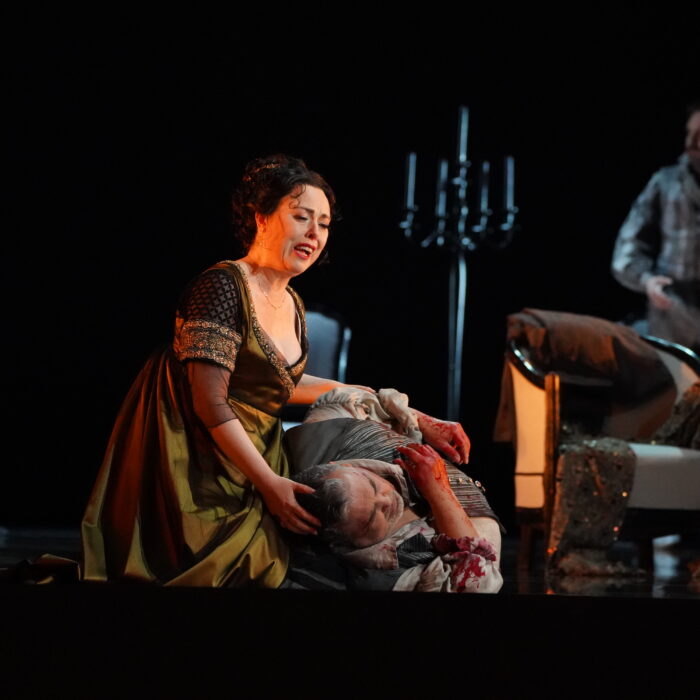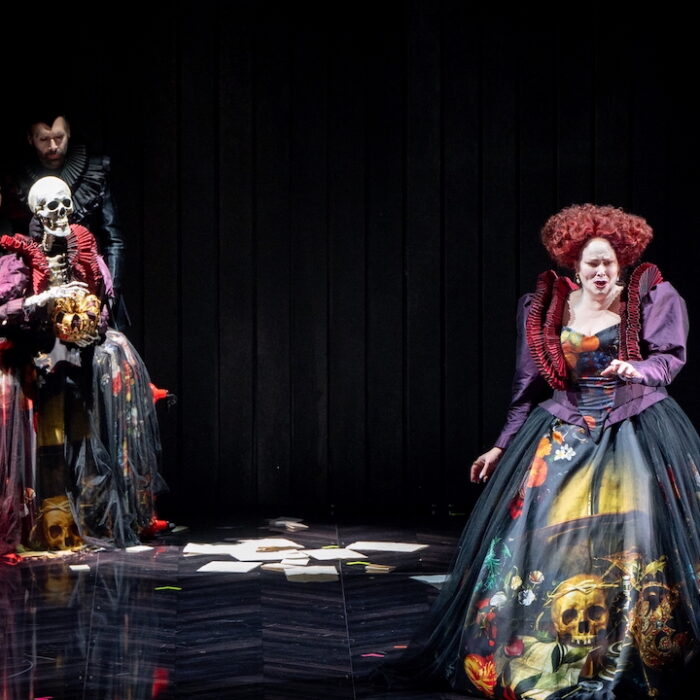
NYU Steinhardt 2107-18 Review – Dialogues of the Carmelites: The Horrors of the French Revolution Portrayed In Potent Manner
By Jennifer PyronA dimly lit stage and full cast of solemn faces set the tone at NYU’s Frederick Lowe theater on Friday night for Poulenc’s “Dialogues of the Carmelites.” Keenly aware of the grave subject about to unfold, audience members reflected back on a tragic time when the French Revolution was taking place in a reluctant and merciless manner. The Reign of Terror left no stone unturned and this opera shows one of the darkest hours ever witnessed.
Leading Lady
Scene one gave the audience anxiety to start, as it showed us the library of the Marquis de la Force in April 1789. Jacklyn Klimczak, as Blanche, was describing her desire to do something more spiritually profound with her life to her father and brother. Klimczak displayed a youthful approach to her character and connection with the internal revolution that she was called to experience in this role. Despite her pleas, the Marquis was relentless with his demands for her to not leave and risk her own life in such a tumultuous time. William Eastland, as the Marquis, delivered a direct vocal introduction to the audience and set the tone for the tragedies that were about to unfold. Christopher Robin Sapp, as Chevalier, wanted to comfort Blanche and somehow relate to her, but could not overcome his fears for her too.
Major Standouts
At the parlor of the Carmelite convent, the audience was introduced to Madame de Croissy and Mother Marie of the Incarnation. Both Briana Sheri and Katherine Robinson showed us how life at the convent is a diligent devotion to God and to each other. Robinson sang about her experience and the audience could feel her devotion to her lifestyle through her vocal phrases. She used a palate of colors to describe all of the emotions that she felt for her convent and describe the rigorous devotion to each sister. Sheri, as Madame de Croissy, was remarkable throughout the opera. Despite the strenuous emotional weight and strength that her character required, she never faltered while singing. One could almost say that she blissfully lost herself in her role and took the audience with her in order to experience the raw and dark times that France was experiencing.
The audience was introduced to Sister Constance of St. Denis, sung by Yixuan Chen, during scene three in the workroom. Chen’s voice was brilliant and really rose to the occasion when portraying a young sister that is full of spirit and joy. Her own gaiety and pure quality of tone was a major highlight during this performance. She instilled hope into everyone and kept shining as a bright star all the way through to the end of the opera.
During scene eight, at the Place de la Révolution in July 1794, the entire cast is gathered to witness the execution of each of the sixteen sisters. One cannot describe in words how excruciating it was to witness the faces of the performers as they prepared for death. The cast was remarkable and placed all of their focus on allowing the music that Poulenc so perfectly had created to wash through them. It also needs to be noted how extraordinary the orchestra, conducted by Michael Ricciardone played. Each member had what it took to emote what Poulenc sought to convey. The Frederick Lowe theater also allowed for the audience to watch each musician perform, adding to the overall feeling of a deeper connection to the music and to the performers. It was incredibly special. When the guillotine made its crashing noise, the witnesses stood still and this moment in time seemed frozen and void of hope. The cast was motionless and it was very moving for all.
Perfect Fits
What sets this opera apart from most is that it was initially performed as a play. Francis Poulenc saw it in 1953, and began work to adapt it into an opera. NYU’s stage director, Michael Scarola, wrote about how he was so deeply moved by this story and how it forever changed his life course. Knowing both the origins and deep rooted connection that Scarola has with this opera, further inspired those that witnessed this performance. The lighting designer, Anshuman Bhatia, was on point with his minimal light-scapes and shadowy folds into a set that was made of dark wood and sheer curtains. The play on textures allowed for the audience to see at all times the light versus dark effect. Costume design by Sarah Jewell Proctor, was also a perfect fit for this opera. Each singer looked the part and the audience traveled back in time to experience what it really must have looked like in France and most especially in a convent. She paid close attention to details and it was refreshing to see such a solid fit for the times.
After the final execution took place and Sister Constance of St. Denis sang her last note a palpable sadness hung in the atmosphere. The audience was left to ponder on all that Poulenc had wished to share through his music and bringing to life this story as an opera. One left the theater in a somber state and would forever be changed by this experience.


